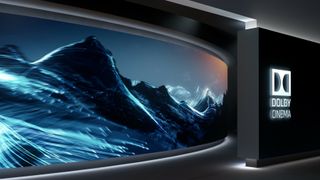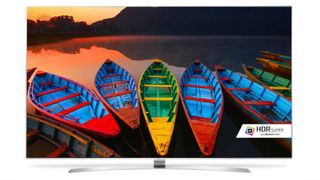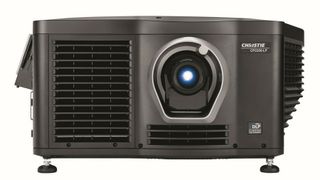Why it's hard to find HDR at the cinema
Is your home cinema better than the local multiplex?

The cinema always used to be the place where you go when you want to experience a movie in the very best quality possible.
But with the arrival of HDR into the home on new 4K TVs, that’s perhaps no longer the case. Add 4K, Netflix, Amazon Instant, smart TVs and UHD Blu-ray and you could be forgiven for thinking there's not much point in venturing into the local multiplex.
"However big your TV and speakers are, they're not as good as the professional equipment in a cinema," says David Hancock, Director, Head of Film and Cinema at IHS Technology, who adds that cinemas are social places with less distractions and more immersion.
“However, HDR in cinemas is rare, and it's unlikely that your local cinema will have it anytime soon.”

Digital conversion
Over the past 10 years the cinema industry has almost completely digitised, shunning its 35mm analogue past for a hard drive and even cloud-powered content, with 4K now creeping in too.
"About 23% of the market is 4K and the rest is 2K from the early digital cinema installations from 2005-2008," says Hancock, "but there's an upgrade path for 2K cinemas."
The core of the system is, of course, the projector, typically supplied by the likes of Christie and Barco. Replacing CRT projectors, digital beamers in 2K cinemas use DLP technology. However, what's coming next – and what's necessary for both 4K and for HDR quality in cinemas – is laser projection.
Get daily insight, inspiration and deals in your inbox
Get the hottest deals available in your inbox plus news, reviews, opinion, analysis and more from the TechRadar team.
New age of laser
When it comes to HDR in the cinema, it's all about those two laser projection brands: Dolby Vision & IMAX.
"The Dolby Cinema laser projection system was co-developed with Christie and is currently only available in Dolby Cinemas using Christie’s 6P modular laser light sources," says Tristan Veale, Research Analyst at Futuresource Consulting, adding that IMAX laser projection is 3D, and a proprietary system.
IMAX's 75ft-wide screen system – which uses two 4K laser projectors – reaches between 4,000‒8,000:1 contrast ratio and Dolby Cinema exceeds 1,000,000:1. To date, 56 movies have been announced or released in Dolby Vision and Dolby Atmos for Dolby Cinema, from Star Wars: The Force Awakens and The Revenant to upcoming titles like Deepwater Horizon and The Great Wall.

So the HDR era in cinemas is coming, or so it would seem.
"In the first quarter of 2016, there were 176 RGB laser projectors in cinemas around the world including IMAX laser and Dolby Cinema," says Hancock. However, HDR-capable cinemas remain thin on the ground.
"There are 216 Dolby Cinemas signed-up around the world, of which about 36 are in operation," says Hancock.
So far, Dolby Cinema has been embraced by VUE Cinemas, UCI/Cinesa, Cineplexx, AMC in the US and Wanda and Jackie Chan Cinemas in China. Meanwhile, IMAX has 33 laser systems already in place – including two in the UK, 15 in the US/Canada, and one in Australia – and plans to spend $60 million over the next four years spreading its tech to around 130 other cinemas.
"So there is a real commitment to HDR on the part of cinemas and investors," says Hancock.

From lamps to lasers
Before we investigate why HDR is so rare in cinemas, it's helpful to know what tech is needed. With the birth of HDR, more brightness is needed, which means cinemas need to upgrade to laser-illuminated projection systems.
Good enough for around a decade without needed a change of light source (the Xenon bulbs of old only last a few months), laser projectors are also a twice as bright as their DLP forbears, and because their light beams are narrower, they can produce far more colour definition. Brighter, longer-lasting and with a wider colour gamut, laser-powered projectors are just plain better.
But there's a problem.
"They start at about $200,000 and go up to about $500,000, and for Dolby Cinema, you need two," says Hancock. It's an expensive investment, though Dolby Cinema is a slightly different business model, being a revenue-share between Dolby and the cinema.
There are actually two types of laser projector: RGB laser, and laser (blue) phosphor. While RGB laser is hugely expensive and designed for large, cutting-edge cinemas – such as IMAX laser and Dolby Cinema – the latter is for up to about 15m screens, it's cheaper, and already exists in about 3,500 cinemas.
Laser phosphor projectors are principally to bring much better brightness levels to 3D movies. "It's the RGB laser projectors that are the problem," says Hancock. "You can only really justify them for the high footfall screens where you can charge a higher ticket price." Those conditions only apply to about 5-10% of cinema screens.

So which is better?
"IMAX only shows 3D whereas Dolby Cinema can do both, so it’s not a straight comparison," says Veale, who adds that the IMAX 3D technology is better than the RealD 3D technology found in most cinemas.
"If you were comparing the same film 2D to 2D, Dolby would most likely provide the best picture, but for 3D vs 3D, IMAX would take the honours," he says. When it comes to audio, it's even: Dolby’s object-based audio called Dolby Atmos is about the same as IMAX’s proprietary 12-channel audio. "But the object-based audio seems to work better if you’re not sat in the perfect middle position of the cinema," adds Veale.

Once cinemas do upgrade to either IMAX laser, Dolby Vision or other RGB laser systems, the industry will once again be top of the tech tree. RGB projectors can achieve the Rec. 2020 colour gamut standard – as yet unused by Hollywood (Dolby Cinema actually reaches way beyond) – which will once again dwarf the capabilities of your TV. However, there is the small matter of Ang Lee's next movie Billy Lynn’s Long Halftime Walk, 11 minutes of which was recently shown to industry execs in Las Vegas and Amsterdam in cutting-edge new tech: 120 frames per second, per eye, and in 4K 3D.
"There is no cinema in the world that could show it, so Christie had to put two specialist laser projectors in, and Dolby had to build a sound rig … it was incredible," says Hancock.
Cinemas can do 4K, or 3D, or 60 frames per second, but achieving all at once is going to take a while.
"Ang Lee was telling me that the image is so good that you can't put make-up on the actors, and you can see the actors acting– including their eye movements – so instead you have to create situations where actors react, not act. He had to re-make how you make a film," says Hancock. "When I was watching it, it was like being the – it was like VR, and at the end everyone's heart rate was up."
So, the takeaway? Your brand new HDR TV might be ahead of the curve for now, but don't get too comfy.
Jamie is a freelance tech, travel and space journalist based in the UK. He’s been writing regularly for Techradar since it was launched in 2008 and also writes regularly for Forbes, The Telegraph, the South China Morning Post, Sky & Telescope and the Sky At Night magazine as well as other Future titles T3, Digital Camera World, All About Space and Space.com. He also edits two of his own websites, TravGear.com and WhenIsTheNextEclipse.com that reflect his obsession with travel gear and solar eclipse travel. He is the author of A Stargazing Program For Beginners (Springer, 2015),

